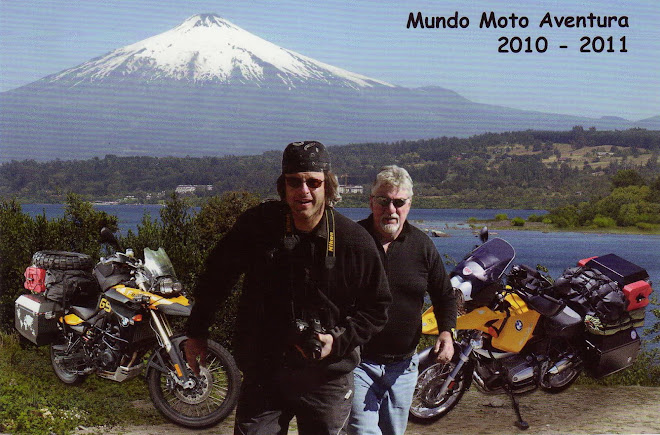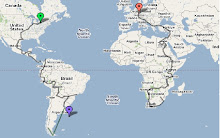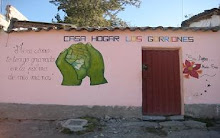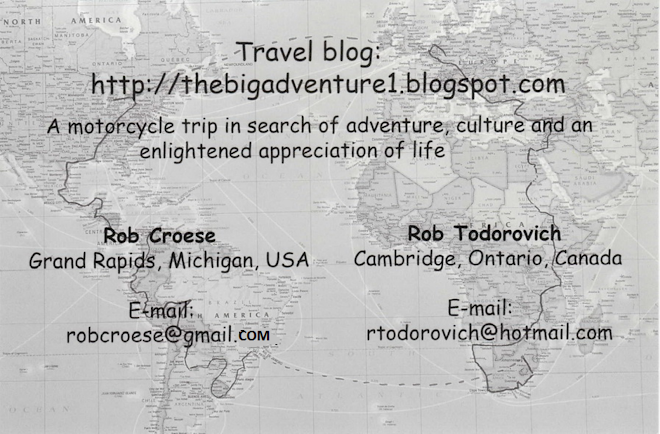At the guard shack.
The road was quite good - packed gravel.
RobC fixing his bent pannier (aluminum Jessie side bag) with a rock, of which there were many in all sizes.In the process he tipped over his bike. We are now 9 (RobC) to 7 (Rob T) in bike tip-overs and falls. At this rate we will be at about 30 each at the end of the trip, unless we get better at keeping the bikes upright. :-)
Lowland rice fields in the valley.(RobC edit: I had only ever seen upland rice in Peru.)
Dry desert mountains.
After an hour we managed to meet up with pavement which lasted all of 5 km before we were into some rough roads again.
Only 84 octane available.
Lunch ... canned tuna, soda crackers and Inca Kola. The Kola tastes like Cream Soda.
The `restaurant``
We met a couple, Dean (Australian) and Renata (Brazilian) on a Ural motorcycle with sidecar . Dean bought the bike and sidecar in Ushuaia, Argentina, from a southbound Alaska to Tierra del Fuego rider. They were headed north traveling together. The bike looked like something out of an Indiana Jones type movie.
Dean and Renata with their Ural machine.
One of the better bridges.
The dot on the road is RobC.
Yup, that's a road on the left and water below.
We finally reached the start of the Cañón del Pato, which has 35 tunnels in 35 km from what I have read. It was originally designed and built as a railroad bed, but it was never completed and they converted it to a regular road. We did start counting tunnels,but we soon lost track because of concentrating on the road and the stunning views!! The road followed the Santa river and was barely one lane wide in spots. There was the odd token guard rail to prevent you from hurtling down a sheer cliff into the raging river below. Tunnels were dark and varied in length from 10 m to several hundred where you had to honk to make your presence known and if you met another vehicle in the tunnel, one would have to back out of the tunnel. Fortunately, we never met another vehicle in a tunnel.
RobC exiting a series of tunnels.
RobC riding the Cañón del Pato road.
Painted desert landscape.
Start of the Cañón del Pato, which runs between Huallanca and Caráz.
Where are the guard rails?!
That's a tunnel on the upper left.
A closer look at the tunnel.
A look inside one of the tunnels. One lane for two-way traffic and a sandy, rutted floor. We feel sorry for the folks who do this on bicycles.
Hydroelectric plant run-off.
We decided we could make Huaráz but not before stopping for a refreshment. RobC ordered some Pisco (distilled grape drink) from a young girl running a restaurant of sorts to warm our bodies, as it was cold and rainy. The store consisted of a square room with piles of crates filled with Coke, Inca Kola and other beverages. There were a couple of makeshift tables in the room as well. She gave her 11 year old companion 50 cents and sent her down the street to procure our desired potion. A few minutes later she was back with a small clear plastic bag 1/4 full of clear liquid. The kind of thing you would bring home a goldfish in, but this one lacked the fish. We poured half in each of two glasses and toasted the ride. OUCH! This was moonshine (aguardiente in Spanish)... sugar cane alcohol ... and it burned!
After dodging potholes for 45 min, we arrived at Huaráz in the dark with cold, rainy and muddy conditions.
Video of Cañón del Pato. WHAT A RIDE!!!
http://www.youtube.com/watch?v=MoBbUFmYanY

















































































